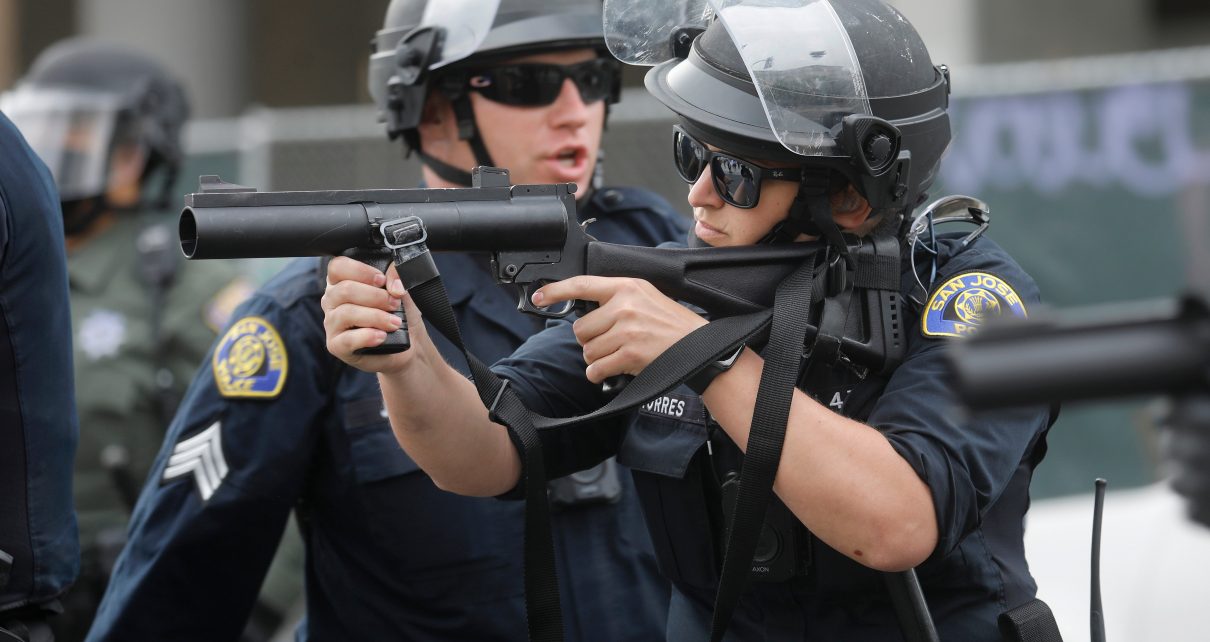During the recent protests over the deaths of George Floyd, Breonna Taylor and other Black Americans, police forces across the country have used weapons categorized as “less lethal” to disperse crowds and subdue individuals. But despite their label, these tools can still overstep the inherent limitations of flesh and bone. Devices that sound innocuous—rubber bullets, tear gas—are designed to quickly change human behavior through force and chemistry. And they are sold as an alternative to the kind of force that immediately kills. Such weapons are not harmless, however.
For starters, they are often used as a prelude to more severe measures, notes Stuart Schrader, an assistant research scientist in sociology at Johns Hopkins University and author of the book Badges without Borders. “One of the reasons it’s a complete misnomer to call [a weapon] ‘nonlethal ’ or ‘less lethal’ [is] if it ’s being used to force people into the [attack range] of cops with batons—or soldiers with rifles,” he says. “In only the most strict technical reading could you call that ‘less lethal ’ or ‘nonlethal.’” And in addition to their use in combination with lethal weapons, these tools can still cause serious injury and death on their own.
Such devices fall roughly into three categories: There are blunt-force weapons, which are designed to hurt people with a physical impact, and chemical agents, which are meant to irritate or incapacitate. A third group comprises specialized technologies ranging from the electric shocks of handheld Tasers to weaponized sound waves.
Blunt Use of Force
Police commonly carry handheld implements—such as batons and shields—that can be employed to injure people. During intense protests, a flashier item has long seen widespread use: metal projectiles encased in rubber, euphemistically termed rubber bullets. From their earliest uses, these bullets have a history of causing lasting injury. While officially designated as rounds that can be fired at the ground to then bounce into people ’s legs, the rubber-encased projectiles often directly hit skulls, chests or eyes. In a 2009 study, researchers at Wayne State University found rubber bullets can hit with a force greater than 3,500 newtons—more than twice as hard as being punched in the side of the head by a professional boxer—which was enough to fracture cadaver skulls.
Militaries and police have employed rubber bullets in many situations, beginning in Northern Ireland in the 1970s and including Washington, D.C., this month. But they are just one example of a family of projectiles, sometimes called “baton rounds,” that have long been used as an alternative to standard bullets. The December 1969 issue of the FBI Law Enforcement Bulletin described one such item used by the British government for riot control in Hong Kong, then a dependent territory of the U.K. The bullet had a teak shell with a small lead insert and was fired by compressed gas. Present-day wooden baton rounds are broader and more puck-shaped. And they have been used by police from Seattle to Ferguson. Beyond rubber and wood, other less lethal projectiles still in use include plastic bullets, which have also caused injuries and deaths, as well as gun-propelled satchels full of lead shot, called “beanbag rounds,” which incapacitate people in much the same way.
In the past couple of weeks, blunt-force projectiles like these have fractured skulls, broken jaws and sent people to the hospital in critical condition. A number of people who say they have lost eyes to baton rounds while participating in or covering the George Floyd protests have indicated they are forming a support group. And a professional association of ophthalmologists has written an open letter asking police to stop using eye-damaging techniques, including rubber bullets.
Chemical Agency
The chemical weapons broadly termed tear gas are officially classified as “lachrymatory agents” because they result in tears—along with nausea, burning sensations, watering eyes and a feeling of breathing difficulty. Thrown canisters and grenades of tear gas produce clouds of powder with an appearance akin to smoke that billow in the air like a mist. On contact with the body, the powder produces the aforementioned reactions, which incapacitate people so they cannot voluntarily resist police.
One of the oldest types of tear gas is the compound CS (2-chlorobenzalmalononitrile), which was formulated in 1928 and popularized in the 1960s for two main uses: as a weapon in support of lethal action by the U.S. military in Vietnam and as a nonlethal way to control crowds—many of them protesting police brutality and the Vietnam War—in the U.S. “To call CS [a] ‘riot control agent,’ as the US military did,” Schrader wrote in Badges without Borders, “was to legitimize its use in Vietnam and make it uncontroversial,” despite the fact that “CS was not used in riot control as much as in combat.”
Military studies performed in the 1950s classified CS as nonlethal. But experts today say these studies had limitations in design and applicability and should be treated with some skepticism. “Tear gas is designed to disperse and irritate. But it was designed and first used in an era when it was assumed it would be used against healthy, working-age males,” says Dan Kaszeta, who studies protection against chemical and biological weapons and has spent some of his 30-year career in the U.S. Army’s Chemical Corps and the Secret Service. Lab studies have not revealed the effects tear gas can have on other demographics or people with preexisting conditions. “There ’s no way to structure an ethical lab study to investigate children, asthmatics, COPD [chronic obstructive pulmonary disease] sufferers, [tuberculosis] patients or pregnant women,” Kaszeta says. He adds that women ’s reactions to tear gas are also not well-studied.
Outside of the lab, tear gas has been shown to cause prolonged damage in people with asthma and to potentially contribute to miscarriages. It has also been linked to death when used in confined and poorly ventilated spaces. Tear gas canisters themselves can be lethal if fired at protesters’ head, as they were in Iraq in October and November 2019.
The other most common kinds of chemical weapons used on civilians are pepper sprays. They were originally devised as an animal repellent, derived from chili plants’ natural defense against mammals. Police adopted the sprays for use on humans starting in the 1980s. In theory, police manuals outline the sprays as a very short-range tool to disperse crowds or prevent immediate harm to officers, bystanders or property. But in practice, police have also used these weapons against sitting and unarmed protesters. They can cause a burning sensation on the skin and produce effects similar to tear gas, including watering eyes and breathing difficulty.
Sound Machine
The long-range acoustic device (LRAD) is marketed as an alternative to police bullhorns and loudspeakers. While it is certainly capable of transmitting messages loudly, it was designed to first warn people and then incapacitate them: The device produces soundwaves deliberately shaped to carry far and at a high volume. It hits a target at up to 152 decibels—enough to cause permanent hearing damage. LRADs come in a range of sizes, most often resembling a large, flat speaker. They can be mounted on a tripod but are most commonly incorporated in vehicles, including dedicated trucks and helicopters.
LRAD use against protesters dates at least as early as the G20 protests in Pittsburgh in 2009. In 2014 the New York City Police Department was sued for turning LRADs against protesters, and the U.S. Court of Appeals for the Second Circuit held that “purposefully using a LRAD in a manner capable of causing serious injury to move non-violent protesters to the sidewalks violates the Fourteenth Amendment under clearly established law.” Journalist Andrew Neef, who experiencedan LRAD in the Pittsburgh protests, described the effect in a 2018 article. “Your brain feels like it ’s vibrating in a bowl of jelly on the table,” he told the Arizona Mirror.
Flash Bangs
Flash bang grenades, also known as stun grenades, have their origins in a hostage rescue mission supported by British special forces in 1977. Flash bangs exist as both hand-thrown grenadelike devices and projectiles that fit into standard 40-millimeter grenade launchers. The “flash” is a sudden bright light that causes ocular pain, confusion and temporary blindness. The “bang” is more than 165 decibels (louder than a shotgun).
These tools are designed to incapacitate anyone nearby who is not prepared for the sound or light and to facilitate the movement of the police or soldiers who toss them. In addition to their use as crowd-control measures, police have also utilized the grenades to gain the element of surprise when entering buildings and homes by force.
A protestor encountering a flash bang in Seattle last month was reported to have been injured by shrapnel. And in general, police flash bangs have caused injuries and deaths, including burns and fatal heart attacks.
Electronic Control
Taser is a well-known brand name that has become the catch-all term for devices formally known as “electronic control weapons.” They are handheld tools that launch a pair of darts designed to hook into a person ’s skin at a target up to 35 feet away. Thin copper wires extend from the darts back to the device, allowing the wielder to deliver a powerful electric shock.
While formally described as a less lethal alternative to explicitly lethal bullets, a 2017 Reuters investigation of more than 700 people who died after being shocked with the weapon found it to be a contributing factor in one fifth of those deaths. Six police officers in Atlanta who used these devices on a pair of students to force them out of their car during protests on May 30 have been charged for an aggressive use of force.




